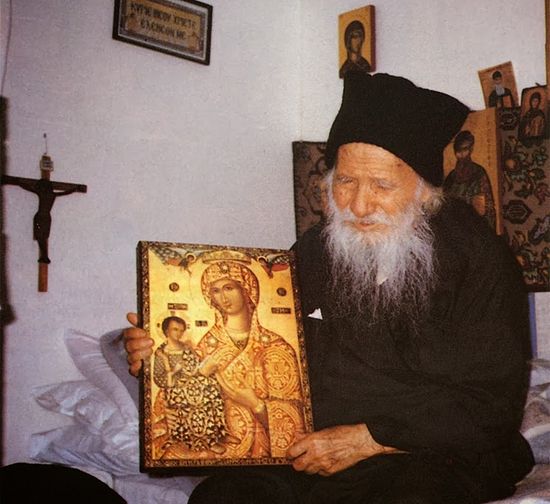The People’s Saint
2 December 2020The holy Elder Porfyrios is an odd sort of saint. He was a monk in the world, he involved himself with an assortment of people, he embraced their pain and recognized them not from their outward appearance but from their soul. In this way he became first a people’s saint and then a saint of the Church. Before his canonization, believers, disbelievers and unbelievers who had felt his touch had already declared him to be a saint.
It wasn’t the representatives of theology or the clergy who first wrote about the holy Elder. It was ordinary people who first wrote, talked and recognized him and they weren’t necessarily people ‘of the Church’. That may be because his very life was testimony to the fact that Elder Porfyrios loved God so much that he served Him in the world, in the streets around Concord Square, in the wards of the clinic, with people who never went to church but were searching. But even those who had had and retained a Christian upbringing he freed from a faith based on habit. He taught them Christ from the beginning. ‘Christ is everything’, he would say, and with these three words he enclosed the whole of the structure of Christianity, showing it to be not a religion but the revelation of God, something for us to experience.

Saint Porfyrios didn’t teach the canons; he respected them but didn’t teach them. Since he said that Christ is everything, he meant that every moment can be Christ-centered. From saying ‘Good Morning’ to saying ‘Good Night’ from parking your car and going to work to the time spent in rest and relaxation. One time, there was a mother with two little girls waiting outside his cell to get his blessing. In front of her there was a woman who didn’t look at all like someone we’re accustomed to seeing in holy places. She was heavily made up and dressed to make an impression. Once she’d gone into the cell, the mother quickly told her little girls about the importance of dressing appropriately in a monastery. Maybe she wasn’t wrong. It’s just that, from what happened afterwards, there was something missing from this admonition. And the Elder provided it. As soon as the woman left the cell, the mother and her daughters went in to kiss the saint’s hand. He looked at the little girls and said affectionately, as if he’d heard the advice given by the mother in the corridor outside his cell: ‘I pray that you’ll be like that woman who was here just now in soul and goodness’. That was it. So simply and so kindly, he justified something which- let’s not beat about the bush- religion is in the habit of condemning. He protected both the woman and the mother from criticism and taught that Christianity doesn’t begin with external appearance and ends with the soul. It begins with the soul and inundates the whole person.
The Elder was a simple man. And he made our faith seems simple, too. ‘Things are simple’ he used to say again and again when people would turn up at the threshold of his cell,complaining about what they didn’t understand and full of fear and despair. This was something the Elder couldn’t get his mind round|: he couldn’t conceive how there was room for fear in the heart of a Christian. ‘Where Christ enters, the darkness disperses’, he would explain and as proof of this, without any effort on his part, he had his face. The holy Elders face was bright and those who knew him, even if, after many years, they’d forgotten his features, the color of his eyes, the shape of his nose and lips, they would still recall that, when they looked at him, his face was bathed in light. Where Christ enters, darkness flees and the Elder’s countenance showed that Christ had entered him completely because there wasn’t a trace of a shadow in his presence. Everything we remember about the Elder is light. His voice was light and you can’t repeat his words with a frown. When you say them, it’s inevitable that you’ll smile and in the smile you’ll find calm. Everything was illumined in the Elder, illumined and bright. And everything present… because although the Elder’s departed, he hasn’t departed. All these years he’s been gone, he’s been vigilant, as he will be in the years to come, helping, supporting and guiding. Saint Porfyrios has been called the saint of technology, the saint of insight. But above all he’s the people’s saint: of those in the Church and those outside, people of belief, disbelief and even unbelief. He’s a saint who was sanctified in our conscience and our daily life so strongly that his canonization couldn’t be long delayed. We felt him to be our saint long before his canonization, we approached him as a saint even when we could still see him, as well as after his departure. His wonderful presence in whatever it was that we were doing loudly declared his sanctity.
Even when we didn’t understand how this Elder had such sanctity, we still felt in our soul that he was a saint. And it may be that this immediate sense of the sanctity of Porfyrios is the best proof in our own time that God has not abandoned us. That He really cares and sends people to remind us that He is everything and that all around Him is light.






